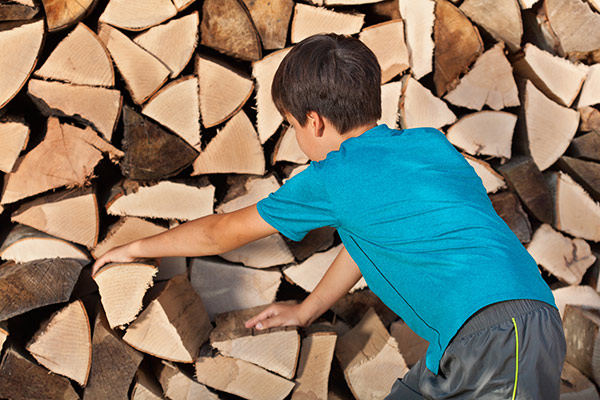
A good fire is impossible to achieve without good firewood. Since freshly cut, green wood isn’t ready for the fireplace, you need to know how to properly store your logs. Storage for firewood isn’t as simple as it may seem. If you don’t store it correctly, you could expose it to infestations, rot and increased moisture. Before you chop and stack your firewood, read these tips on storing firewood to make sure you aren’t making things more difficult for yourself.
How to Store Firewood Outdoors
When you have fresh wood, you’ll want to leave it outside with as little cover as possible. Freshly cut wood is full of moisture which makes it inefficient to burn. When you expose it to air and sun, you reduce the time needed to dry it out. However, you can’t just set it outside and hope for the best. There are some steps you should take for proper outdoor storage for firewood.
Keep Firewood Off the Ground
The most important part of storing your firewood is to keep it above the ground. If you set your firewood on the ground, the bottom logs won’t have a chance to dry out. Not only will they receive no airflow, they can absorb new moisture from the soil or grass. It’s also likely your firewood will develop mold growth or rot in these conditions. The mold can spread to other logs and greatly reduce your supply of functional fire burning logs for the season.
Most people will use a wood shed to store their wood. In addition to keeping their wood off the ground, wood sheds offer other benefits to simplify storage for your firewood. If you don’t have a wood shed, you can use a simple pallet or some 2x4s to raise the woodpile above the ground.
Cover Your Firewood – But Not Completely!
Outdoor firewood storage is by far the best way to dry it out for the upcoming winter. However, most areas of the country that get cold enough for fires tend to experience a healthy supply of rain too. While a little moisture won’t set you back for the entire season, an uncovered wood pile can easily reabsorb a lot of rain. And when they become saturated, moisture will sit on the logs and seep in – prolonging the drying period.
If you don’t have a wood shed, you can cover your wood with a resilient tarp. The tarp will stop most of the rain from landing on the wood. Make sure the tarp is high quality. It’ll have to endure the elements all year – and wind will make it rub against the wood, which causes the logs to sand holes into cheaper tarps.
Don’t make the mistake of using the tarp to cover the wood completely, though! Remember, you’re trying to expose the cut logs to air and sun. The more you cover them, the less exposure they receive. Your tarp should only cover the top of the pile with a few inches of overhang. Leave the front, back and sides open to give them a chance to dry out!
The Right Stack Makes a Difference
After a long day of chopping wood, you may be tempted to throw it all in a big pile. Proper wood stacking isn’t just about aesthetics – it’s a key step to get seasoned wood. There are a few things you should know when you go to stack your firewood.
Don’t Leave Your Wood in a Loose Pile – In addition to looking sloppy, a loose pile of green wood will prevent proper airflow from reaching a large volume of your supply. The inevitable gaps also make a great home for larger pests. While it’s hard to avoid spiders or insects, a loose pile of wood invites mice and other rodents.
Don’t Stack Wood Against Your Home – While you can stack your wood next to your home or another structure, don’t use other wood or your home to stabilize your pile. In addition to reducing airflow, it can also cause the fresh wood to pass unwanted moisture to other wood piles or your home. It’s recommended to leave two to three feet of space between the wood pile and any non-woodshed structure.
Can I Store My Firewood Indoors?
Yes, but in most cases it’s not a good idea. For starters, when you bring wood into your home, you’ll bring anything attached to it as well. Termites can be a big problem – but even harmless pests can be a nuisance when you invite them into your home. Ventilation is another concern. Even if your home has a good amount of airflow, it won’t dry as quickly as it would outside. You’ll end up needing more time to properly season your wood.
Tips for Properly Storing Your Firewood
Give Your Wood Enough Time Dry
Unseasoned firewood produces more smoke than properly dried wood. The more smoke there is, the more deposits are left in your chimney. If you frequently burn fires that are very smoky, you may need more than the typical annual chimney cleaning to prevent dangerous buildup. The time it takes to dry your firewood can vary dramatically. Weather, climate, the type of wood and how you store it all impacts the length of time you need before it reaches an optimal moisture level for the fireplace. The more wood you keep, the less likely you are to run out of seasoned wood when you need it.
But Don’t Give It Too Much Time
Keep in mind that wood can be overly dry, too. The ideal moisture content for most firewood is around 20 percent. When it’s been dried below this percentage, the wood will break down much more quickly and produce extra smoke. Not only does this leave you burning more wood, it can lead to fireplace backpuffing.
Keep Your Wood Pile Away from Doors & Trees
Choosing the spot for your firewood pile matters more than you may think. If you stack firewood near doors to your home, it increases the chances that insects will wander from the wood pile into your home. Likewise, woodpiles near trees make them easier for insects like bark beetles to crawl from the tree to your wood and cause havoc.
First In, First Out
The best way to properly cycle through your firewood is to use the oldest logs first. This may mean restacking your wood so it’s easier to access older logs, but it’s worth the trouble.
Inspect Your Logs Before Bringing Them Inside
When you’re ready to stack a few logs near the fireplace, give them a close inspection. It only takes a few seconds to identify infestations or rot. It’s far easier to keep these things out of your home than it is to remove them once inside.
Don’t Bring in More Than You Can Burn
The best practice with firewood is to burn it as soon as you bring it inside. This makes it much more difficult for insects to make their way into your home. While it‘s a little more work to constantly walk in-and-out to keep the fire going, it’s better than trying to solve a termite infestation.
Get Your Fireplace Ready – Call Doctor Flue!
With cold weather just around the corner, now is the perfect time for your annual chimney inspection! Contact us today so your fireplace or stove is ready to burn your stack of firewood this season.
Call Us: 1-800-438-3583
Email Us: office@drflue.com
Office Hours: Mon-Fri: 8am-4pm
Connect with Doctor Flue on Social Media

